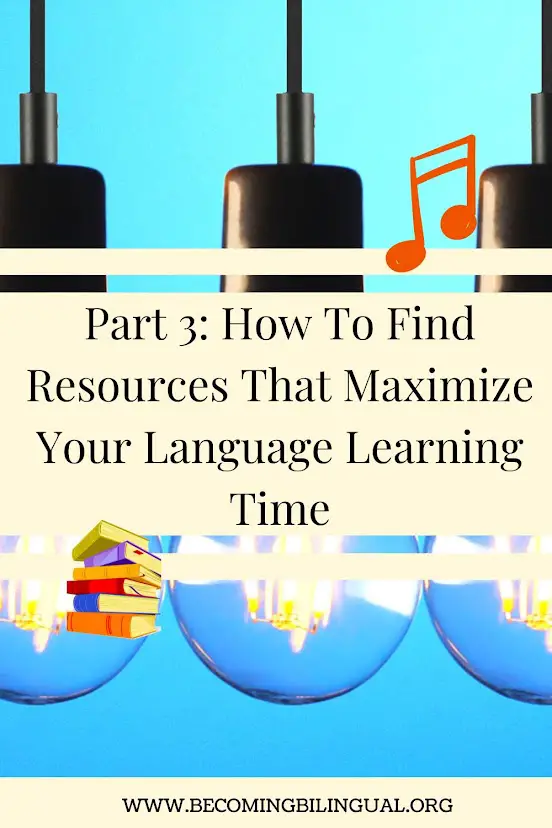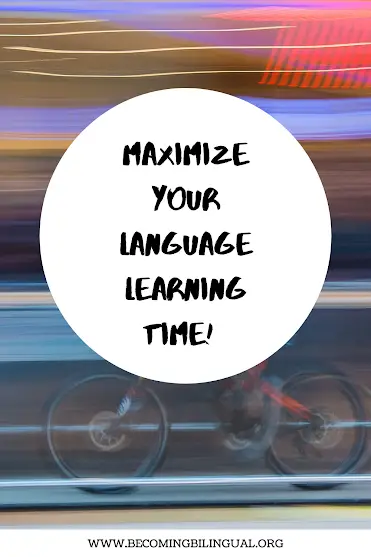How To Find Resources That Maximize Your Language Learning Time

Last Updated on April 22, 2022 by Reina Victoria
Welcome back to my four part series “How To Teach Your Child A Second Language: A Quick Start Guide”!
The first two parts of this series focused on the best age to teach your child a second language and how to create a language learning schedule. Today I’d like to talk to you about how to find child friendly resources that maximize your scheduled times and proficiency level. Don’t forget to check out the final installment of my series next Monday!
Teaching your child a second language requires a lot of resources, especially if you aren’t fluent in that second language.
When I made the decision to raise my daughter bilingual, I knew that I was going to need Spanish resources that allowed her to hear native and fluent Spanish as well as grammatically correct Spanish.
Finding resources that maximize your family’s language learning time is so important to your child’s bilingual success. I’m going to show you how to analyze the types of resources that you need and how you can go about finding them.
Don’t forget to tune in next Monday for the final part in this four part series!
Part 3: How To Find Resources That Maximize Your Language Learning Time
How well do you know the target language?
One of the first things to consider before you start searching for resources is how much of the target language you already know.
If you or your spouse is already bilingual, then you should be looking for resources that expand the depth and richness of your child’s vocabulary and will build upon what they are already hearing in the home.
You may have some basic understanding of the target language. Perhaps it’s the language that you studied in high school and you remember a few basic words and phrases and may be able to read some isolated words.
If you have a foundation in the language, however small, you can look for basic print resources that can refresh and expand your vocabulary and also provide you with phrases that you can start to use at home.
This could be a brand new language for you as well, and you may be starting at square one, just like your child. In that case you’re going to need to find as many beginning resources as possible, most of which will be auditory, so that you and your child can both gain exposure to the language together.
Remember, language learning needs to be interactive for your child, so you need to find some way to engage in the language with them, even if you don’t know it yourself. It’s going to be important to find resources that support you and your child working together.

How Old Is Your Child?
Your child’s age is also going to determine the types of resources that you get for language learning. Here are some ideas of the types of resources that you’ll want to use to target your child’s development stage.
Children Aged 0-3
Nursery rhymes
Toys with target language audio
Board books
Children Aged 3-6
Nursery rhymes
Music
Toys with target language audio
Shows
Picturebooks
Podcasts
Children Aged 7-12
Music
Toys in target language
Shows
Picturebooks
Chapter books
Books on tape
Podcasts
Apps
Teens Aged 13-18
Music
Shows
Chapter books
Books on tape
Podcasts
Apps

Look at the schedule to see what you need
Now it’s time to take a look at your schedule and see what resources you can get to help you teach a second language to your child. Let’s go back to the example of the monolingual family that is trying to teach Spanish to their five year old.
Neither of the parents speaks Spanish but they both took it in high school and have some recollection of words and phrases like, “Hello, my name is…”. They had created their schedule and decided that they would like to embed Spanish learning into three parts of their evening:
Car Ride – 10 minutes
Spanish Show – 20 minutes
Bath/Shower – 15 minutes
Now that they’ve determined how well they know the language and when they want to use it, they can look for resources to maximize their Spanish learning as a family.
We’ll start with the car ride: The family drives home from daycare with their 5 year old and spends about 10 minutes in the car and the best resources to use in the car would be audio resources.
They can look for music, books on tape, and podcasts to immerse them in Spanish language for that entire 10 minutes.
Considering their child’s interests they could look for music from a popular movie or TV show that’s translated into Spanish, nursery rhymes, a children’s audiobook of fairytales or podcasts that are directed towards children or produced in ‘slow Spanish’.
The TV time that they do after dinner will be an easy switch to Spanish language time. Most shows have audio options where you can switch the language to Spanish.
Since this family is learning Spanish alongside their child, it is important that they also watch the show with their child and engage in the action that is happening.
Trying to pick out familiar or repeating words and use those to describe the story line are great ways to boost the language learning time.
Many DVDs have a Spanish language option that is easy to switch to and other popular services like Netflix also have Spanish options for almost all of their shows.
Bath/shower time was another area that this family chose to try and work in some Spanish language. One way that they could use Spanish during this time is through songs.
Learning Spanish translations of songs like, “It’s raining, it’s pouring” and “Row, row, row your boat” could be easily adapted to water play.
They could also find translations for the names of the bath toys their child uses to engage them with that vocabulary.

Finding the resources
Now that you have an idea of the types of resources you need, it’s important to find quality materials.
One of the first stops that you can make is to your local library. Many libraries have books and CDs in other languages. If they don’t have the resources you’re looking for, they can often direct you to a place in town or a neighboring library that does carry them.
The internet! There are so many sites that provide free and printable resources for families looking to teach their child another language. Many of the sites also include recommended books, shows, toys, and music that you can download or find to use.
There are also lots of popular services that you already have that offer translations into various other languages. Sources like Amazon Music, Disney Plus, and Netflix offer a wide variety of language options.
Blogs! There are families all over the world that are raising their children to be bilingual and multilingual and that are blogging about it! You can read about their experiences and what they used to help their children learn the target language.
If you’re starting Spanish as your second language, you can use the resource that I have on my site here.
There are so many resources available to help get your family started on your language learning journey! Think about the best time in your day to work on language learning with your child and find what works best for you.
If you need any support in your journey or are looking for resources, drop me a comment here and I’ll help you out!
Stay tuned!!
Next Monday I will release the final part in the series, “You Can Do It! – Motivation For Bilingual Parenting”.
The final part will take a look at how you can stay motivated to learn a language at home, despite some challenges you may face. Staying motivated, reaching out to support groups and being consistent in your language learning will give you and your child the gift of a second language!
Happy Learning!
This post is part 3 in a series. If you didn’t get to check out the other parts, check them out here!
Part 1: What Is The Best Age To Teach Your Child A Second Language
Part 2: How To Create A Language Learning Schedule
Part 4: You Can Do It!- Motivation For Bilingual Parenting
Don’t forget to subscribe here and get my latest posts and resources delivered straight to your inbox!
I am so happy that you commented on my blog. I’m in love with this series and will be binge reading your posts tonight! I am self taught in Japanese and my partner is Japanese so we are trying to teach our daughter. She is 2 so she is at the nursery rhymes stage but it seems to be working! We are currently long distance so creating a schedule with audio resources will definitely come in handy for me!
I’m glad that you’ve enjoyed the series and it’s great that you’re raising your daughter to be bilingual! We used a ton of audio resources in the beginning, especially because that helped me to also improve my language skills. We still use audio resources a bunch because we generally spend about an hour a day in the car. Do you have audio books or podcasts that you use in Japanese?